 Topic: What is the gap between the top of tire to wheel well after lowering your car? (Read 3446 times)
previous topic - next topic
Topic: What is the gap between the top of tire to wheel well after lowering your car? (Read 3446 times)
previous topic - next topic

 Topic: What is the gap between the top of tire to wheel well after lowering your car? (Read 3446 times)
previous topic - next topic
Topic: What is the gap between the top of tire to wheel well after lowering your car? (Read 3446 times)
previous topic - next topic